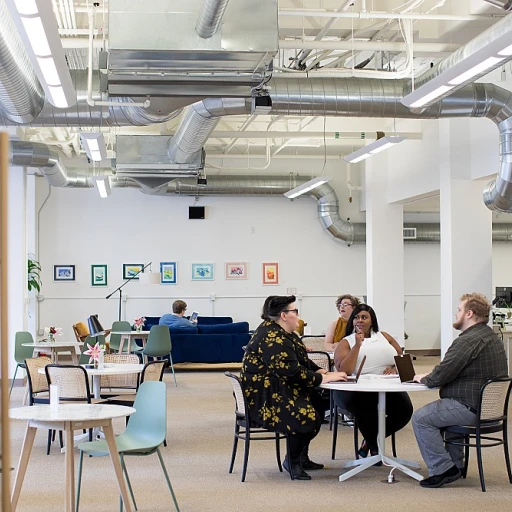
Understanding Collaborative Teaming
Fostering a Cohesive Environment for Team Collaboration
The essence of collaborative teaming lies in uniting diverse group dynamics to work toward a common goal. In both the workplace and educational settings, understanding how teams function can significantly enhance their outcomes.
Team collaboration thrives on the participation of all team members. Every contribution, from sharing ideas in team meetings to engaging in decision making, strengthens the group’s ability to solve problems efficiently. As such, it becomes crucial for teams to maintain open lines of communication and invest time in learning about each other’s strengths.
Collaborative learning environments, both in professional and student settings, emphasize the importance of respect and understanding among members. This environment nurtures innovative thinking, while offering support to every team member, thus promoting a unified team effort.
Effective collaborative teams prioritize time management and structured team building activities. These initiatives not only improve communication but also help teams tackle challenges head-on. Essentially, the synergy among team members fuels a productive and innovative collaboration team, primed for achieving success together.
Building Trust and Communication
Fostering a Culture of Trust and Open Dialogue
In any collaborative team, trust and communication form the backbone of successful interactions. When team members trust each other, they are more likely to engage in open dialogue, share ideas freely, and support one another in achieving the common goal. This trust is not built overnight; it requires consistent effort and genuine interactions.
To cultivate trust, teams should prioritize transparency in their communication. This means being honest about challenges, sharing successes, and being open to feedback. Regular team meetings can serve as a platform for this, allowing team members to voice their thoughts and concerns in a safe environment. Encouraging team members to actively listen and respect diverse perspectives can further strengthen the bonds within the group.
Effective Communication Strategies
Communication is a critical component of any collaborative effort. It involves not just the exchange of information but also understanding and empathy. In a collaborative workplace, effective communication can be achieved through several strategies:
- Active Listening: Encourage team members to listen attentively to each other, ensuring that everyone feels heard and valued.
- Clear and Concise Messaging: Avoid jargon and be clear in your communication to prevent misunderstandings.
- Feedback Mechanisms: Implement regular feedback sessions to help team members improve and grow.
- Use of Technology: Leverage tools that facilitate seamless communication, such as collaborative platforms and instant messaging apps.
By focusing on these strategies, teams can enhance their communication, leading to more effective collaboration and problem-solving.
Building Interpersonal Relationships
Strong interpersonal relationships are vital for a collaborative team. When team members know each other well, they can work together more effectively. Team-building activities, both inside and outside the workplace, can help in this regard. These activities provide opportunities for team members to bond, learn about each other's strengths and weaknesses, and develop a sense of camaraderie.
Moreover, fostering a culture of collaborative learning can significantly enhance team dynamics. Encouraging team members to share their knowledge and skills not only benefits the group but also promotes a culture of continuous learning and improvement. This approach can be particularly beneficial in diverse teams where members bring different experiences and perspectives to the table.
For more insights on enhancing communication and collaboration in the workplace, consider exploring this comprehensive guide.
Encouraging Innovation and Creativity
Cultivating Innovation in Team Environments
Innovation is a crucial driver for success in any collaboration team, enhancing creativity and creative decision making. When teams work together, they combine diverse perspectives, allowing unique ideas to flourish. But how can team members be encouraged to bring out their creative side, and how can this creativity be harnessed effectively?
Fostering a safe environment is key, where individuals feel comfortable sharing their thoughts and engaging in collaborative learning. Providing support and eliminating the fear of failure can significantly enhance team collaboration. Team meetings should be structured to encourage open communication, where every group member's input is valued and considered.
- Encourage team members to take risks with ideas.
- Create an environment where collaborative teams embrace innovative solutions.
- Foster learning culture for continuous improvement.
A successful collaborative team understands that genius ideas often stem from passionate discussions. Time spent in team meetings should focus not only on tasks but also be a playground for creativity. A collaborative workplace must reinforce the importance of balancing creative and analytical processes to achieve common goals.
Moreover, team building activities can spark creative thinking by allowing members to experience different viewpoints and problem solving methods. By investing in professional learning opportunities and emphasizing the importance of innovation, team dynamics shift positively towards achieving common goals.
For additional insights on how innovation can be leveraged in various professional settings, explore how file management solutions play a role.
Overcoming Challenges in Collaborative Teaming
Navigating Obstacles in Team Collaboration
Cultivating a successful collaborative team can be challenging. Effective collaboration requires time, dedication, and a proactive mindset to overcome common hurdles present in group settings. In any group dynamic, communication is key. Team members must be adept in sharing ideas and actively listening to others. Miscommunication can lead to conflicts, which can stall progress towards common goals. Teams should establish clear communication strategies early on. Regular team meetings and open channels for dialogue can significantly support team members in maintaining transparency and commitment to shared objectives. Diversity in perspectives often enhances decision-making processes. However, it can also lead to differing opinions and potential discord. This is where problem-solving skills become invaluable. Encouraging respectful discourse and fostering an environment where contrasting ideas can coexist helps in converging towards innovative solutions. Another challenge is balancing individual contributions with collective efforts. Collaborative learning environments emphasize the value of each team member’s input while aligning them with the team's overarching mission. To prevent any imbalance, it’s crucial to support each member's growth and assign roles based on their skills and experiences. Time management is yet another obstacle teams face. With various priorities and schedules to manage, ensuring timely progress can be difficult. Establishing realistic timelines and clear priorities with the help of collaborative teaming practices increases the chances of keeping projects on track. Overcoming these challenges demands continuous learning and flexibility. Teams that commit to improving their collaboration workplace practices will not only enhance their team dynamics but also generate a more productive and positive work environment for everyone involved.Measuring Success in Collaborative Teaming
Key Metrics and Feedback for Collaborative Teaming
In the pursuit of a productive collaboration workplace, it becomes crucial to ascertain how well a group operates and meets its common goals. Measuring the success of collaborative teaming involves a blend of qualitative and quantitative analysis. Let's delve into the essential metrics and feedback systems that aid in this process:- Team Performance Metrics:
- Collaboration and Communication Quality:
- Innovation and Creativity Levels:
- Trust and Interpersonal Relationships:













